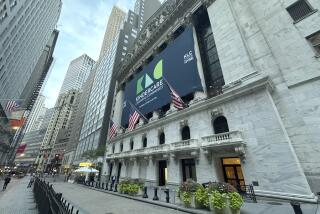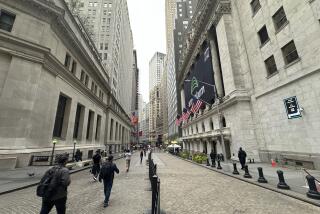Dow Index Has Record Plunge : But 39.1 Decline Is Less Serious Than Drop in ’29
The Dow Jones index of 30 industrial stocks took its biggest one-day tumble in history Wednesday, falling 39.10 points from the record high reached the day before.
Until Wednesday, the greatest decline in a single day had been the 38.33-point drop--to 260.64--recorded on Oct. 28, 1929, the day before the storied “Black Tuesday,” when the market fell an additional 33 points, leading ruined investors to jump off tall buildings.
But the latest slump in the Dow Jones industrial average was much smaller in comparative terms than the 1929 declines because the Dow index today stands at a much higher level. Wednesday’s drop was a 2.5% slide in the index, compared to the 12.8% decline on Oct. 28, 1929. “It’s a mere pittance,” one analyst said.
Nonetheless, Wednesday’s decrease wiped out $47.45-billion worth of market value of stocks, reducing the total value to $2.14 trillion, as measured by an index compiled by Santa Monica-based Wilshire Associates.
The Dow Jones industrial average fell Wednesday to 1,526.61 from Tuesday’s record close of 1565.71. Other, broader indexes of New York Stock Exchange activity declined but not as dramatically as the Dow. The American Stock Exchange and the over-the-counter market also were down.
A total of 180.33 million shares changed hands on the New York Stock Exchange, the fifth heaviest trading day on record. Volume Tuesday was 152.95 million shares.
Analysts described Wednesday’s sell-off as a healthy correction in a market that has been surging unchecked since September.
Market ‘Vulnerable’
“The market has been increasingly vulnerable to a correction, and it has been looking over its shoulder,” said Monte Gordon, an analyst with Dreyfus Corp., a mutual fund firm based in New York. “It has been increasingly laboring and working harder to hold its line.”
“There was a stampede to get into this market, and Wednesday there was a stampede to get out of it,” said Michael Metz of New York-based Oppenheimer & Co.
Analysts said that the sell-off was sparked by several factors, including a major decline in the bond market and a prediction by Henry Kaufman, chief economist for Salomon Bros., a New York investment house, that the Federal Reserve Board is unlikely to cut the discount rate, an about-face from an earlier prediction. Both developments were based in part on improved unemployment statistics released Wednesday, which indicate a firming in the economy.
Much of the increase in stock market prices during the last two months was fueled by expectation of a decline in the discount rate, the rate at which Federal Reserve banks lend money to financial institutions, which currently stands at 7.5%.
‘Junk Bond’ Rule
Another factor in the market’s decline, analysts said, was Federal Reserve Board approval Wednesday of a rule intended to place restrictions on the use of high-yield, low-rated securities, called “junk bonds,” to finance corporate takeovers. As a result, traders began unloading the stock of possible takeover candidates, they said.
The decline in stock prices accelerated late in the day as futures markets raced ahead of the stock market. Futures contracts permit investors to bet on the direction of certain stock indexes. When the futures market indicated that stocks might be bought later at a price even lower than Wednesday’s, investors unloaded the stocks they held and bought futures contracts instead.
“People were selling whole baskets of stocks against futures positions,” Metz said.
Opinions varied on the severity of the damage of Wednesday’s decline. Some analysts thought the stock market would rebound quickly, but others saw a longer period of lower prices and perhaps volatile swings in the market.
Another Rally Seen
Metz did not predict the start of a bear market. “It is late in the bull market, but there will be another decent rally starting in the next few days,” he said.
Chester Pado, director of technical research at Los Angeles-based Jefferies & Co., said that the market is entering a “corrective phase” that could last well into February. “For the time being, I think you’ve broken the backbone of the great enthusiasm that fueled the market,” he said.
Wednesday’s decline “underscored the vulnerability and the ability to lose money in the market,” Pado said. “For a while, there was a euphoria and people were forgetting that you could lose money in the market.”
Market Rise Predicted
Pado predicted that the market will resume its climb and that the Dow Jones Industrial Average could end the year close to 1,800.
More to Read
Inside the business of entertainment
The Wide Shot brings you news, analysis and insights on everything from streaming wars to production — and what it all means for the future.
You may occasionally receive promotional content from the Los Angeles Times.










